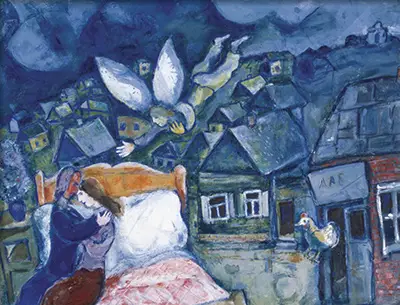Despite the tragedy and human suffering that Chagall must have witnessed this is a work full of hope, beauty and love.
From the charming figure of the angel swooping down from the heavens, to the intimate portrait of two lovers, there is optimism and joy flowing from Chagall's brush.
Born in 1887 into poverty in Russia (in an area that some years later was to become Belarus), Chagall had little early exposure to art of any kind and it wasn't until he was in his early teens that he began to develop his skills.
His early work was heavily influenced by his Jewish roots and by the hard working life of those around him and these were themes that remained with him throughout his later work, albeit often hidden or filtered through a wealth of other experiences and influences.
Chagall moved to France in his early twenties and was soon under the spell of the nascent Modernist art movement, allowing his work to grow and flourish in what was undoubtedly one of the most fertile environments that the art world has ever known.
The Dream, with its richly textured choice of blues and greens is a classic example of Chagall's maturing work. Focussing on a limited pallet allows the artist to draw the viewer into the work, to marvel at the myriad ways that just a few different shades can create such a variety of shape, shadow and depth.
As with much of Chagall's work the painting draws heavily on childhood memory and nostalgia, and in The Dream we can see a townscape that harks back to his early life in the small town where he grew up. Visible too in the distance is the often present religious symbolism, this time in the form of the chapel on the hill. There is a solemnity in the shadows of the background that is lightened by the contrast with the figures at the bottom left of the canvas, and the joy and delight in watching the two lovers embrace gives the work a sense of tenderness that lessens any darkness that may be present below the surface.
Chagall's work often plays off light and shade in such a manner, offering us a reminder that without night there can be no day. The work, like many of Chagall's masterpieces also uses the language and imagery of dreams, and as is obvious from the title of this painting, Chagall wants us to travel with him on this most personal of journeys into the psyche. The bed, the lamp, the figures all appear to somehow be floating above the sleeping town.
Out of context, yet unremarkable in the world of the subconscious, we see a chicken floating with the couple. In the fluid nature of the dream state, as we look at the couple more closely we wonder perhaps if we have read the relationship correctly. Could this be a mother comforting her child rather than the romantic embrace we had first assumed?
Whatever story we choose to see, there is no doubt that the figures represent the optimism and love that exist in even the darkest of times; the painting, we recall, was made in 1939.
In The Dream we see Chagall combining a powerful imagination with a nuanced and thoughtful use of colour and a daring ability to abandon tradition to create a beautiful and unique work that offers hope in what can sometimes seem like a hopeless world.
